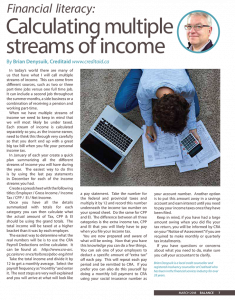The following article originally appeared in the Manitoba Teachers’ Society Balance Wellness Magazine.

In today’s world, there are many of us that have what I will call multiple streams of income. This can come from different sources, such as two or three part-time jobs versus one full-time job. It can include a second job throughout the summer months, a side business or a combination of receiving a pension and working part-time.
When we have multiple streams of income, we need to keep in mind that we will most likely be under taxed. Each stream of income is calculated separately so you, as the income earner, need to think this through very carefully so that you don’t end up with a great big tax bill when you file your personal income tax.
In January of each year create a quick plan summarizing all the different streams of income you will have during the year. The easiest way to do this is by using the last pay statements in December for each of the income streams you had.
Create a spreadsheet with the following titles: Employer / Gross Income / Income Tax / CPP / EI / Net Income.
Once you have all the details summarized with totals for each category you can then calculate what the actual amount of Tax, CPP & EI should be using the grand totals. The total income will be taxed at a higher bracket than it was by each employer.
The easiest way to determine what the real numbers will be is to use the CRA Payroll Deductions online calculator. It can be found at:
http://www.cra-arc.gc.ca/esrvc-srvce/tx/bsnss/pdoc-eng.html
Take the total income and divide it by 12 to get a monthly average. Select the payroll frequency as “monthly” and enter it. The next steps are very well explained, and you will arrive at what will look like a pay statement. Take the number for the federal and provincial taxes and multiply it by 12 and record this number underneath the income tax number on your spreadsheet. Do the same for CPP and EI. The difference between all three categories is the extra income tax, CPP and EI that you will likely have to pay when you file your income tax.
You are now prepared and aware of what will be owing. Now that you have this knowledge you can do a few things. You can ask one of your employers to deduct a specific amount of “extra tax”off each pay. This will repeat each pay period and be remitted to CRA. If you prefer you can also do this yourself by doing a monthly bill payment to CRA using your social insurance number as your account number. Another option is to put this amount away in a savings account and earn interest until you need to pay your income taxes once they have been filed.
Keep in mind, if you had a large amount owing when you did file your tax return, you will be informed by CRA on your “Notice of Assessment” if you are required to make monthly or quarterly tax installments.
If you have questions or concerns about what you need to do, make sure you call your accountant to clarify.

